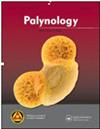Spatial Distribution of Anemophilous Pollen and Its Correlation with the Asian Summer Monsoon on the Southeastern Tibetan Plateau
IF 1.3
4区 地球科学
Q3 PALEONTOLOGY
引用次数: 1
Abstract
ABSTRACT Previous studies have discovered arboreal pollen in non-forested areas on the Tibetan Plateau, which are mostly anemophilous type and regarded as a result of the Asian summer monsoon. However, the relationship between the spatial distribution of wind-pollinated pollen and monsoon has seldom been illustrated quantitatively. Here, we used 676 surface samples (647 compiled, 29 new samples) to examine the characteristics of the spatial distribution patterns of 13 anemophilous pollen taxa on the southeastern Tibetan Plateau, by employing the spatial interpolation technique. Then, we quantified the correlation between the distributions of these taxa and monsoon wind via Mantel test. The results show that the anemophilous pollen represents at least half percentage of the total pollen assemblages in most areas of the study region. Anemophilous tree pollen mainly distributes in the south and southeastern part, while anemophilous non-tree pollen does in the opposite and perpendicular direction. The distributional pattern of non-anemophilous pollen reflects that their corresponding plants most likely constitute the understory components of different forests or the minorities of non-forests communities. Mantel tests indicate that the anemophilous tree pollen has a highest correlation with the Asian summer monsoon. Anemophilous pollen, overall pollen assemblages and anemophilous pollen with air sacs have higher correlations with summer monsoon. Contrarily, non-anemophilous pollen has relatively weak correlation. Furthermore, we found that the relationships between various pollen groups or separate taxa and the Asian summer monsoon are dependent on sample types. The lake sediment surface samples had the strongest signal of the Asian summer monsoon among the different sample types. Our findings provide the strong evidence of the Asian summer monsoon influencing the pollen distribution patterns. More importantly, the quantification of this correlation between anemophilous tree pollen and the Asian summer monsoon offers the fundamentally theoretical basis of reconstructing paleo-monsoon by the proxy of windborne pollen taxa.青藏高原东南部风性花粉的空间分布及其与亚洲夏季风的相关性
以往的研究发现,青藏高原非森林地区的树栖花粉多为嗜风型,被认为是亚洲夏季风的结果。然而,风传粉花粉的空间分布与季风之间的关系很少得到定量的说明。采用空间插值方法,利用676个地表样本(已整理样本647个,新增样本29个),对青藏高原东南部13个喜风花粉类群的空间分布格局特征进行了研究。在此基础上,通过Mantel检验量化了这些类群的分布与季风的相关性。结果表明,在研究区大部分地区,风性花粉至少占总花粉组合的一半以上。风性树花粉主要分布在南部和东南部,非风性树花粉分布在相反和垂直方向。非风性花粉的分布格局反映了其对应的植物极有可能构成不同森林的林下成分或非森林群落的少数成分。曼特尔试验表明,风性树花粉与亚洲夏季风的相关性最高。风性花粉、总花粉组合和带气囊的风性花粉与夏季风的相关性较高。相反,非风性花粉相关性较弱。此外,我们还发现不同花粉群或不同分类群与亚洲夏季风的关系取决于样品类型。在不同的样品类型中,湖底沉积物表层样品的亚洲夏季风信号最强。本研究结果为亚洲夏季风影响花粉分布模式提供了有力证据。更为重要的是,对亚洲夏季风与风性树木花粉相关性的量化研究,为借助风传花粉分类群重建古季风提供了根本的理论依据。
本文章由计算机程序翻译,如有差异,请以英文原文为准。
求助全文
约1分钟内获得全文
求助全文
来源期刊

Palynology
地学-古生物学
CiteScore
3.40
自引率
26.70%
发文量
48
审稿时长
>12 weeks
期刊介绍:
Palynology is an international journal, and covers all aspects of the science. We accept papers on both pre-Quaternary and Quaternary palynology and palaeobotany. Contributions on novel uses of palynology, review articles, book reviews, taxonomic studies and papers on methodology are all actively encouraged.
 求助内容:
求助内容: 应助结果提醒方式:
应助结果提醒方式:


